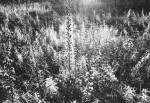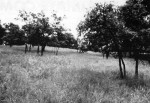Studying the processes that allow species to reassemble and persist following disturbances
The permanent LTER plots, and those in the experimental manipulations, are providing a detailed record of the sequence and timing of species invasions, expansions, and losses during the natural restoration of native ecosystems
The Cedar Creek group plans to begin a major new experimental study of the effects of biodiversity that promises to be a rich intersite resource
Among the Long-Term Ecological Research sites, Cedar Creek Natural History Area (CDR) is unique because of its location on the climatically and edaphically controlled boundary between prairie and forest. It sits at the transition between the eastern forested LTER sites (Coweeta, Hubbard Brook, Kellogg) and the western grassland LTER sites (Konza, Central Plains, and Jornada), and has interesting similarities and differences with Sevilleta. This “tension zone” between forest and prairie is highly sensitive to climatic variation and strongly impacted by edaphic factors, fire frequency, and herbivores and predators. The 2,200 hectares of Cedar Creek include large tracts of oak savanna, prairie and successional grasslands, oak forest, and smaller stands of basswood-sugar maple, white pine, jack pine, and red pine, all of which have been shaped by these forces. Moreover, the dominant vegetation of the region, oak savanna, itself has unusually high species richness because its flora and fauna include both prairie and forest species.
Research Questions
The diversity and dynamics of these ecosystems form the unique foci of the CDR program. In addition to the LTER core areas, three major questions guide the research:
- ‘What factors control the successional dynamics of abandoned agricultural fields as they return toward native prairie and savanna?
- What forces determine how many species can persist within each of the trophic levels of our ecosystems,-i.e., what controls biodiversity?
- What are the impacts of biodiversity on the stability functioning of these ecosystems? In addressing these questions, CDR seeks a synthesis of population, community, and ecosystem perspectives, and employs a combination of long-term experiments and observations.
Succession, the process of ecosystem assembly, and biodiversity are tightly linked. The dynamics of succession, and the factors that drive successional processes, are the processes that allow species to invade into a habitat and persist with other species. The environmental constraints, organismal tradeoffs, and feedback effects that control the rate, pattern, and direction of succession are likely to be the forces that maintain these features, including biodiversity, once successional changes cease. Because successional dynamics are the dynamics of community assembly, they should provide insights into the forces that control and maintain diversity.
Cedar Creek contains numerous stands of native savanna and a rich chronosequence of over 100 successional grassland fields of known ages, ranging from newly abandoned to 67 years post- agriculture. The permanent LTER plots in this chronosequence, and those in the experimental manipulations, are providing a detailed record of the sequence and timing of species invasions, expansions, and losses during the natural restoration of native ecosystems.
During the past 10,000 years, the vegetation of Cedar Creek has fluctuated between forest, prairie, and savanna in response to climatic variation and/or the effects of climate on fire frequency. Climatic conditions during the first 12 years of study were extremely variable, which has provided unique insights into the effects of climatic variability on population, community and ecosystem processes. These insights were only possible because the long- term data provided a temporal context against which the climate change effects could be measured.
For the past 12 years, CDR researchers have been gathering a richly detailed record of the dynamics of successional grasslands and prairie openings, and of their response to climatic variations and other disturbances. They have performed numerous long-term experiments that have provided insights into the underlying forces that control the composition, successional dynamics, and diversity of these systems. Site work focuses on these factors, and on how the interactions and feedbacks among them determine the species composition, dynamics and biodiversity of the study ecosystems, Specifically under study are the processes that allow several hundred vascular plant species, a similar number of insect species, a dozen small mammal species, and numerous soil invertebrate, decomposer and mutualistic fungal species to reassemble and persist after disturbances. Also studied are the effects of biodiversity on the dynamics and stability of population, community and ecosystem processes.
Significant CDR findings have depended critically on the long-term observational and experimental records accumulated at the site. The long-term record was essential for discerning the effects of drought on grassland and savanna biodiversity, and for determining the effects of plant biodiversity on drought resistance and resilience in successional grasslands and savanna. The CDR group were “fortunate” that one of the four worst droughts of the past 160 years occurred after they had collected data from five climatically normal years. This allowed the measurement of drought effects, and the dynamics of recovery from drought, against a known baseline. It was not until 1993, five years after a once-in-50-years drought and 12 years into the LTER project, that many plot traits, including species richness, productivity, and abundances of some major plant species, had returned to pre-drought levels.
New Biodiversity Experiment
The CDR group has just completed a six-year renewal proposal, with plans to continue the core long-term experimental and observational studies on succession and biodiversity, expand the oak savanna studies, and begin a major new experimental study of the effects of biodiversity. New personnel on the grant include Dr. Peter Reich, University of Minnesota, who will spearhead the oak savanna work, and Dr. Mark Ritchie, Utah State University, who will expand his work on predation and trophic cascades.
The objective of the new biodiversity experiment is to control plant species diversity in ‘a well- replicated, long-term field experiment to determine the effects of plant species richness and plant functional-group richness on:
- Stability of primary productivity in response to natural and experimentally induced climatic variation and in response to herbivores, pathogens, seed predators, and disease
- The species composition, abundances, stability and diversity of herbivorous insects, seed predators, predaceous insects, and parasitoids
- The densities, dynamics, stability and habitat choice of small mammals
- The dynamics of soil C, N, and other nutrients, including rates of accretion, leaching losses, rates of mineralization, rates of fixation, and turnover of pools
- The dynamics, species composition and biodiversity of soil micro- and macroorganisms, including soil mycorrhizal fungi, nitrifying bacteria, other bacteria, other fungi, soil microarthropods, earthworms, and soil arthropods.
The experiment consists of 210 440m2 plots randomly assigned to one of seven general treatments:
- Bare soil
- Monoculture
- Two plant species
- Four plant species
- Eight plant species
- 16 plant species
- 32 plant species.
This work promises to be a rich intersite resource, and the CDR group invites interested researchers to participate.
David Tilman, University of Minnesota, Department of Ecology, Evolution and Behavior, 100 Ecology Building, 1987 Upper Buford Circle, St. Paul, MN 55108, 612-625-5743, dTilman@LTERnet.edu

 Enlarge this image
Enlarge this image
